Subscribe now and get the latest podcast releases delivered straight to your inbox.
Content Managers: Use This Step-by-Step Guide to Create the Content Your Team Needs

By John Becker
Oct 12, 2023

The 9 steps of content marketing production
- Brainstorm the idea
- Write an outline or interview questions
- Conduct research or interview
- Write your draft
- Edit what you wrote
- Get approval
- Stage your content
- Final check
- Publication and promotion
To all you new content managers reading this, let me start by saying, welcome aboard!
I’m sure you’re excited to get started, nervous about the pressure, and unsure of exactly what comes next. That’s totally normal. At IMPACT, we’ve helped hundreds of content managers find their footing and get started.
After all, what you’ve heard is true: You’re at the center of the whole buyer education movement at your new company. You will have more to do with its success than maybe anyone else. If you’re succeeding, the company will succeed.
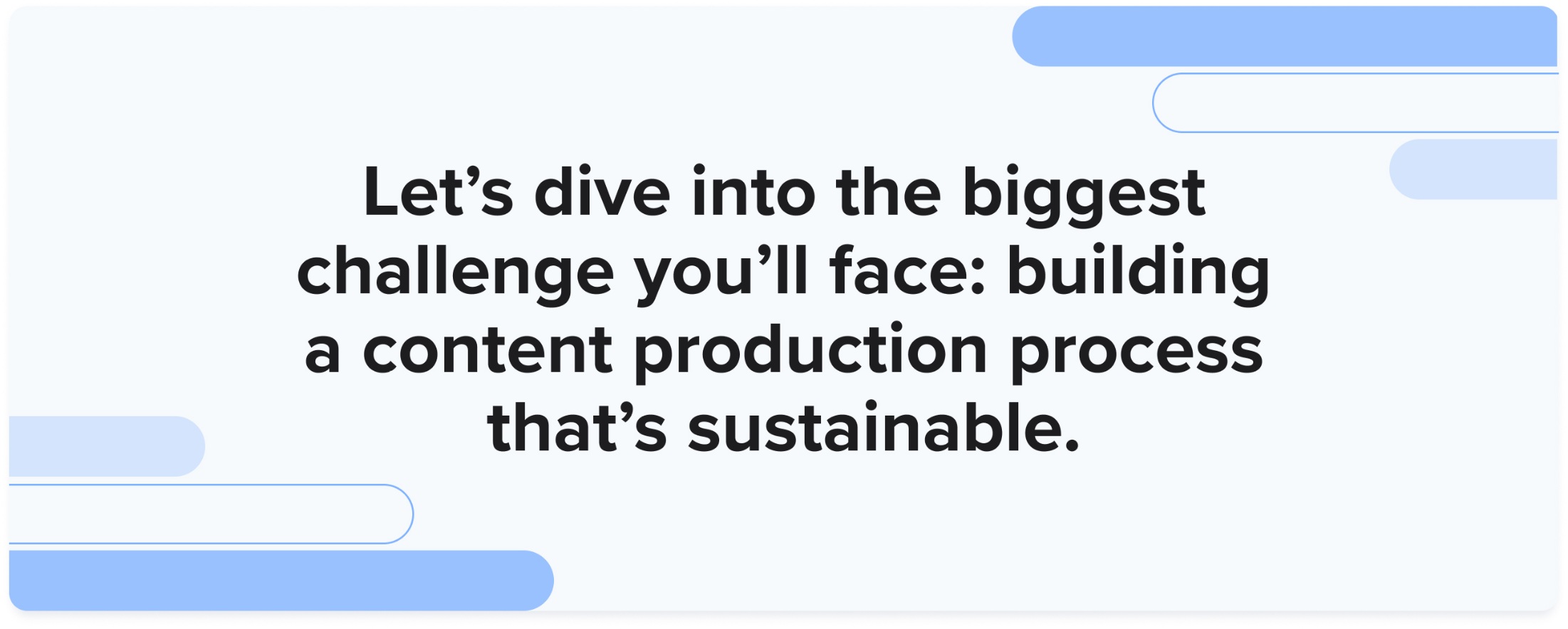
You’ve been hired for a reason. You’ve got the writing chops and interviewing skills that make you perfect for this role. So don’t sell yourself short, and don’t succumb to imposter syndrome. You’re here to help people — to provide the resources they need to solve their problems. You’re the perfect hire. And you’re going to do great!
So let’s dive into the biggest challenge you’ll face: building a content production process that’s sustainable. All you need to do is follow the steps below for each piece of content, and make sure you have a few pieces going at any one time.
Do that, and you — and your company’s content marketing initiative — will succeed.
Follow the steps, learn the process
The content creation process is pretty simple. It’s a linear progression that moves from initial idea generation to final publication and promotion. If things are firing on all cylinders and you’ve got a high-need piece of content, it’s possible to get that piece through all the stages, from brainstorm to publication, in less than a week.
In most cases, though, each blog post or video or case study spends a good deal of time waiting to move forward — and much of this will be beyond your control. In reality, each piece of high-quality content could take several weeks from start to finish.
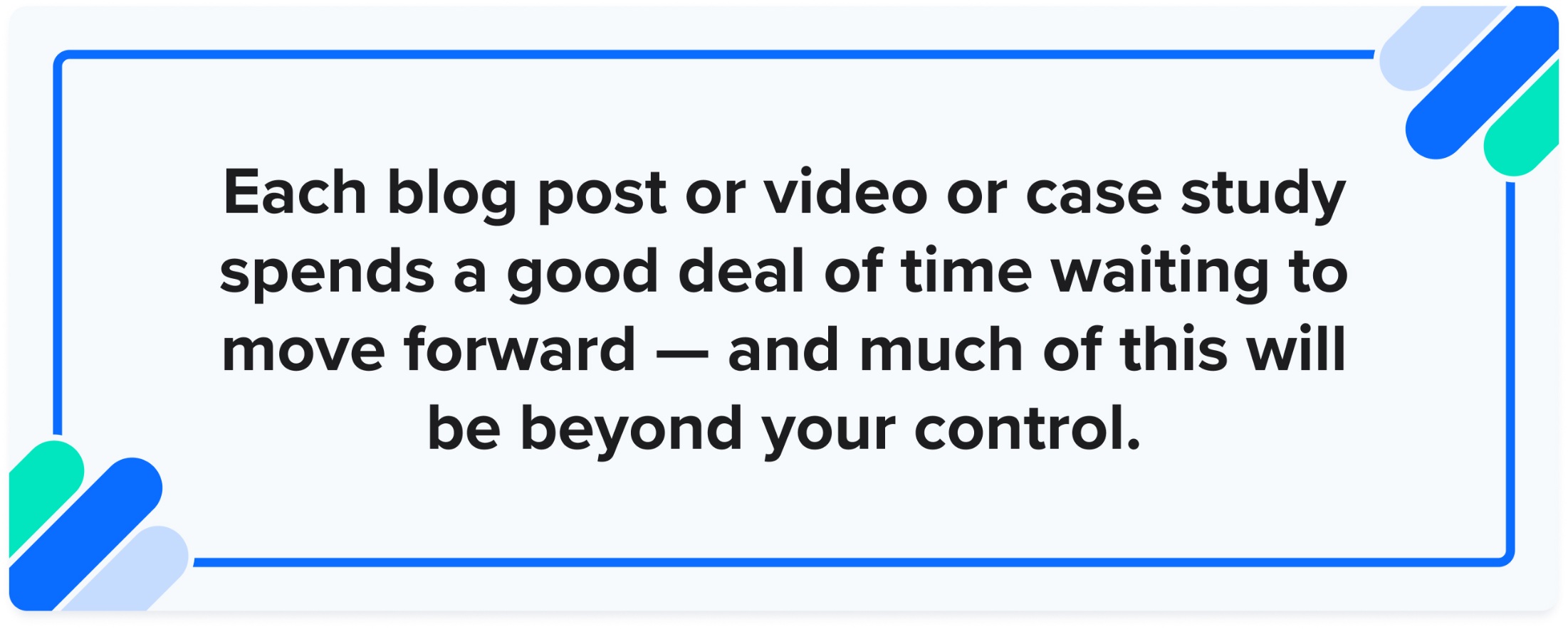
Knowing that you’re we recommend that you publish three pieces of content each week, you’ll need to have quite a few pieces in production at any given time. We call that “building your pipeline,” and here’s a full article that explains exactly how you do that.
But for now, let’s look at the steps you’ll follow for each piece of content. Each piece you write will follow the same general process, which I’ll outline.
Be sure to use the attached resources for more information.
The steps of the process:
- Brainstorm the idea
- Write an outline or interview questions
- Conduct research or interview
- Write your draft
- Edit what you wrote
- Get approval
- Stage your blog article
- Final check
- Publication and promotion
Let’s dive into each one.
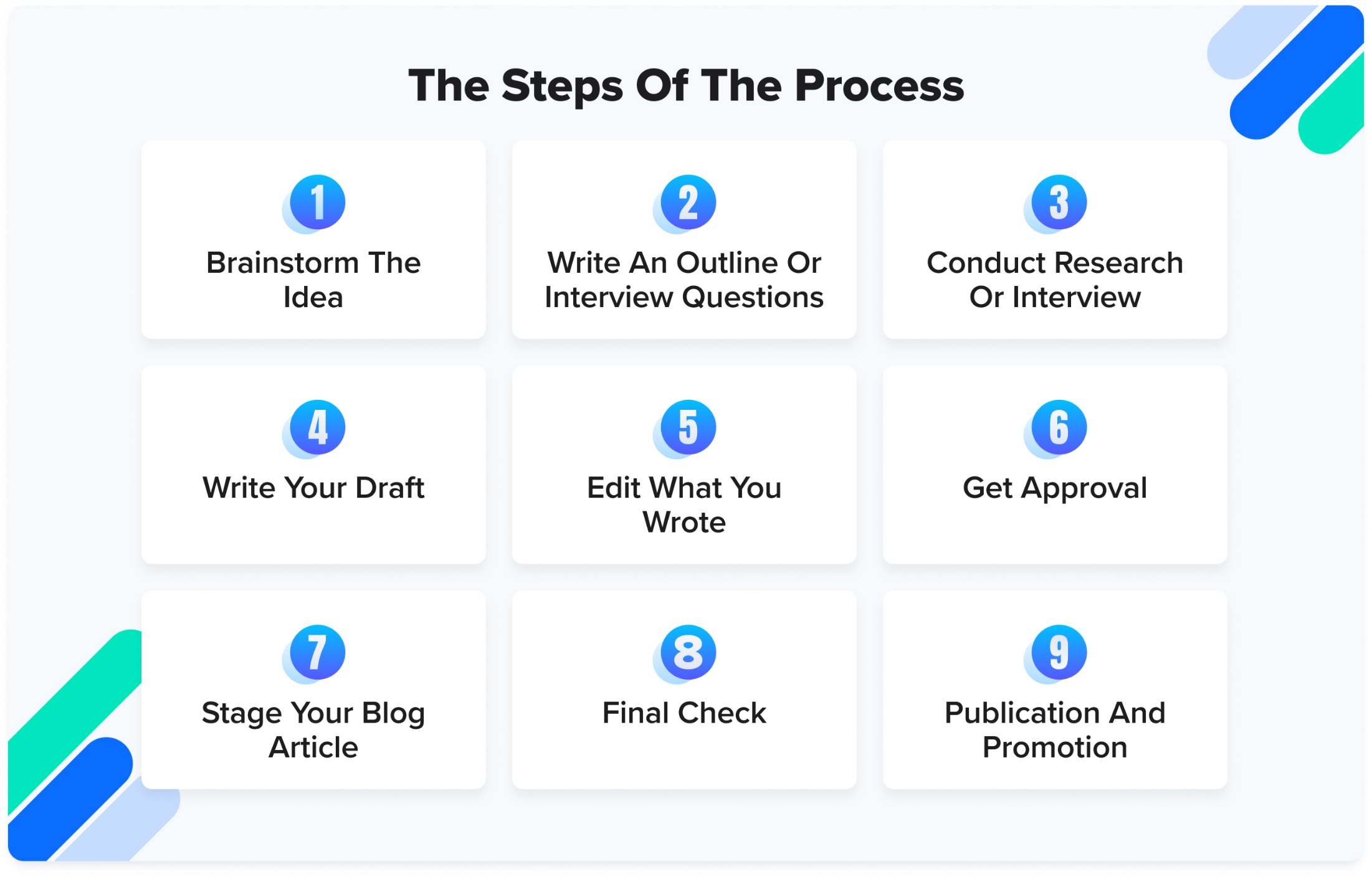
1. Brainstorm the idea
Every article starts as an idea. That idea can come to you from a number of different places:
- A dedicated content brainstorm session with specific team members
- A requested need from the sales team to specifically answer a question that has come up in recent calls
- Keyword research
- A half-baked idea that pops into your head (or a colleague’s head!)
- Conversations with existing customers
- From leadership or a product team to support the launch of a new offering
- AI tools that help you brainstorm on your own
No matter where the ideas come from, let me say this: You should ALWAYS be collecting content ideas. Some might be dead ends, but most will have promise. Put them in the backlog or find some other way of organizing and prioritizing them.
A steady stream of high-quality content ideas is crucial to content marketing success, so plan to build pathways to collect and solicit ideas at regular intervals.

Remember, any time you’re collecting an idea for an article, be ready with a few follow-up questions so that you get the full scope of what you’ll be writing about. I always try to think about the following:
- Who is my target audience? In other words, who wants to know this? Is it a small business owner? A computer programmer? A backyard DIYer? My tone and focus will be different depending on who I’m writing for.
- What do they really want to know? What are the follow-up questions that feel most natural for prospective customers? What’s the one thing the reader wants to take away?
- How can I best help them? Remember, the goal of your content is to be helpful, so keep this question in mind from the very start of the process.
This way, you don’t end up with half-baked ideas. Rather than having a uselessly broad topic like “metal roofs,” you have a focused topic like “how metal roofs compare to shingle roofs.” Even that might be too broad. Better still: Cost comparison: Metal roofs vs. shingle roofs.
Now that's the good stuff.
If you want to learn more about brainstorming, click here. If you want to explore important blog topics, click here.
2. Write an outline or interview questions
Give your topic direction by writing an outline. I know writing an outline feels a little bit like high school, but trust me, it’s worth it. This is not the time to not know where you’re going. You’ll be able to write better content if you have a structure in mind before you get started.
An outline: This doesn’t have to be formal or detailed. I like to write my headers in order so I know the progression the piece will take. If you’re having trouble, brainstorm a list of related questions. If you’re writing about the cost of metal roofs vs. shingle roofs, you might break that down into installation costs vs. maintenance costs — or add in other factors such as color and thickness, and how these relate to cost, durability, and other factors.
Interview questions: You might not have all of the information to write the article. You might need to interview another expert at your company. These subject matter experts (or SMEs) are a goldmine. They have the answers that will make your content authentic and helpful.
If I’m going to interview an SME for a piece, I write a series of questions (usually about five or six) that will help me get the information I think I need to fully address the topic. You’ll get a feel for this once you’ve done it a few times.
Use AI to help you if you get stuck.
3. Conduct research or an interview
Now you have a direction and an outline. Next, you’ll need to do some research. The research process can look very different depending on your industry. Just keep in mind those rules you learned in high school that you swore you’d never need again: Use trustworthy resources, cite those sources, and make sure you’re saying something original.
If you’re conducting an interview to get the information you need, you’re on a different track. I provide a lot more detail about interviewing in the resource below. In general, follow three rules and you should do fine.
- Don’t waste the person’s time.
- Make sure they enjoy the process (and make sure they like you).
- Say thank you.
I record every interview I conduct, whether over Zoom or in person. I then use Descript to get a rough transcript. Then I have a scannable resource where I can find exactly what the person said in response to my questions. It also means I don’t have to take notes during the conversation.
You can use AI tools like Audiopen or ChatGPT-4 to help you summarize — but watch closely for details that might get missed.
More details about interviewing can be found here.
4. Draft the article
When you have the outline done and have gathered the information you need, you’re ready to write. As Donald Miller writes in Building a StoryBrand, there are two critical values you must convey in your work: Empathy and authority.
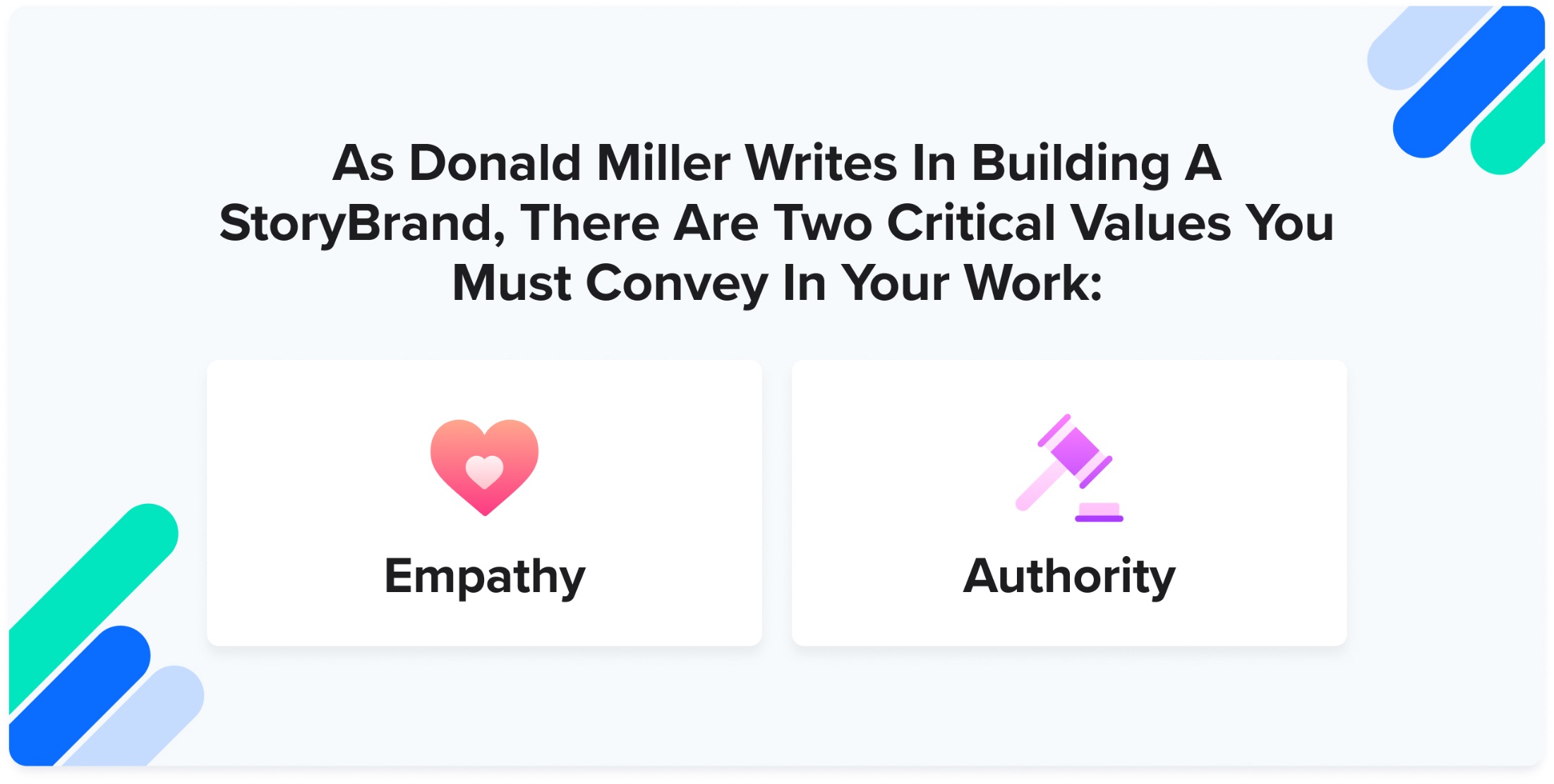
Empathy: Readers are coming to your content because they need help. Whether their basement just flooded and they don’t know if they can file an insurance claim or they need a new project management software platform for the office, they are facing a challenge. In order for your content to resonate, they need to know that you understand. They need to know that you empathize.
Authority: But you can’t just understand. Their neighbor can understand. You need to be able to help them. This is where the authority comes in. Why should they listen to you? Because you’ve helped hundreds of homeowners with their insurance challenges, or because 75% of companies who use your project management system are more efficient and happier.
When you’re writing, keep these two things in mind at all times. Try to establish both early on.
The content trainers at IMPACT use a “PEP” method to coach their clients when writing an introduction. If they’re able to do these three things, they will have established empathy and authority and hooked the reader to keep reading.
Our content trainers break it down like this:
- Problem: What problem are people experiencing? You need to immediately connect with the reason they're here in the first place. Clearly articulate the problem and show the stakes for not solving the problem.
- Expertise: Why should your reader trust you? Establish your expertise with a low-key plug. This can be as simple as "Here at River Pools, we go on over 100 sales appointments every year to discuss fiberglass pool installation." It will be clear to your reader that you know your stuff if you're helping that many people every year!
- Promise/Preview: Offer a quick breakdown of topics the article will cover. What will readers know by the end that they didn’t know before they started?
Once you’ve clarified the problem, conveyed your expertise, and offered a preview of what’s to come, you can dive into the meat of the topic.
This should be your wheelhouse.
You’ve been hired because you’re a strong writer, so trust your instincts. The writing should be the easy part.
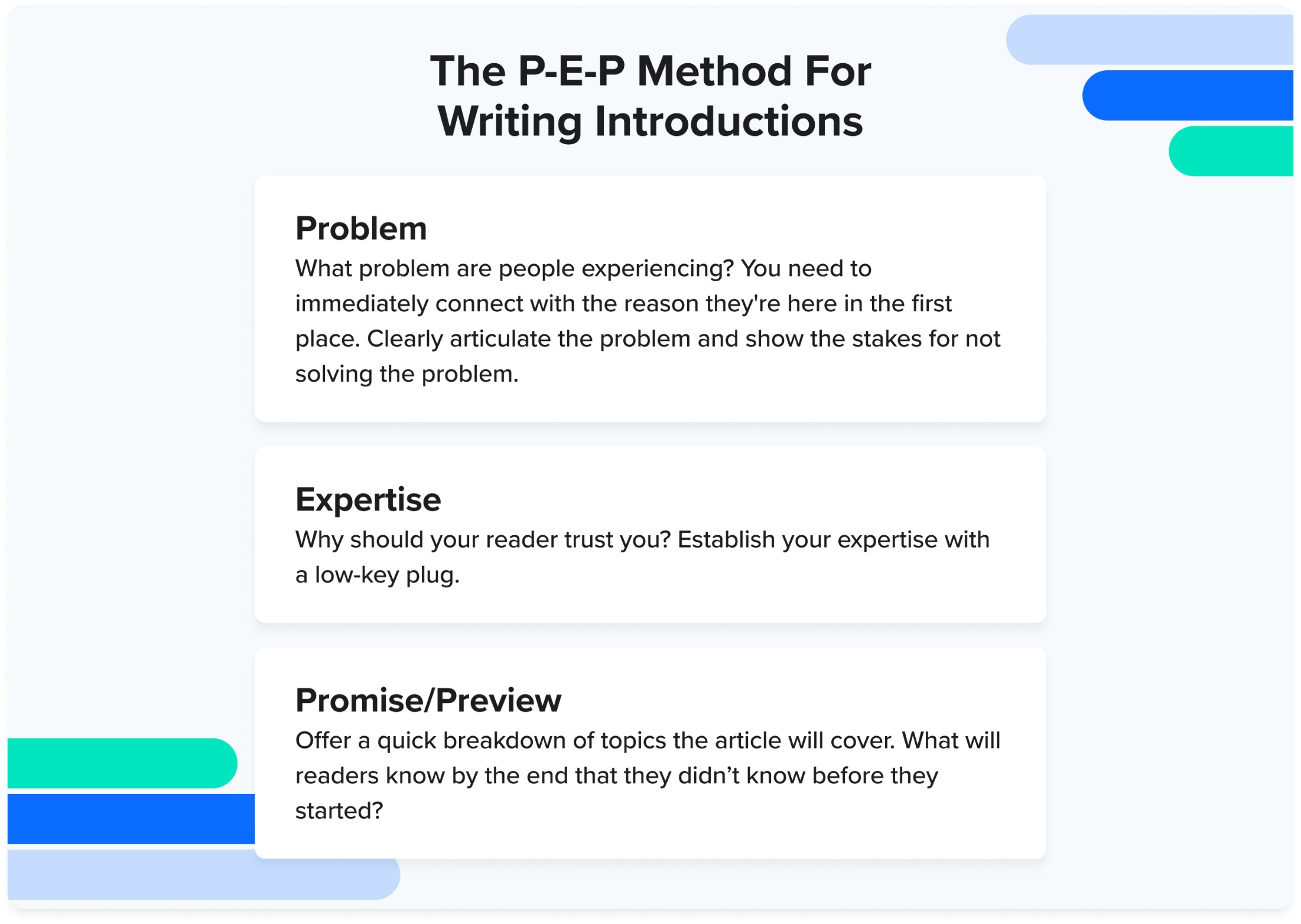
Just like with an interview, don’t waste people’s time — and make sure they enjoy the process of reading your work. This isn’t college, where you’re trying to pad your term paper to get it to reach 10 pages. Be concise. Put the simple answer toward the top, with more details to follow if people need them.
5. Edit your work
Congratulations: You’ve written the first draft. Remember, though, your first draft will not be the one you show to the world.
Next comes editing.
If you’re doing your own editing, make sure you let the piece sit for a day or two before you go back to it.
Then, read it closely. Read it out loud. Tinker, polish, adjust. Don’t rush through editing, especially if you've used AI to help you draft. You’re next going to share this with colleagues, so make sure you’ve done your work so they’re not finding too many typos.
You can use apps such as Grammarly or the Hemingway editor if you find them helpful.
If you have a copy editor or a boss who wants to edit for you, so be it. Just remember you might lose a day or two in turnaround time before it gets back to you.
6. Get approval
Someone should look at what you write before it goes live. The approval process can vary widely. It may include:
- Checking in with an SME to make sure the writing sounds authentic.
- Running something by your legal team to avoid any entanglements.
- Sending the article to the person you interviewed to make sure you captured their voice and tone.
- Sending the piece to a C-level executive for approval.
- Checking with a videographer or designer if there are multimedia elements in the content.
Use a Trello board or any task management tool to track content through the approval process. Be aware that these steps might take time. Try to set expectations when you reach out to any colleague.
Send a note like, “Hey, Alice, here’s a draft of that article I’ve been working on. Could you give it a look and get back to me with feedback by EOW? Thanks!”
This way, they know the timeframe they’re working with (make sure you’re giving them at least a few days), and you have an opportunity to follow up if they don’t get back to you.
Also, realize that in some cases you might not be heading off to Step 7 at this point. You might be going back to editing.
7. Stage your blog article
When your draft is fully edited and approved, you’re almost at the end. It’s now time to stage — that is, to put the text into your website’s blogging or publishing platform.
Now, it might not just be the article. The content may also include images, GIFs, videos, graphs, and other elements, as well as headers, footnotes, links, and more.
You need it all to look great and be easily readable, so staging should not be rushed.
The staging process can be time-consuming and intricate. Your steps will be unique, but should probably include all of these:
- Optimize your images so they’re each around 100 Kb. Use a tool such as Bulk Resize Photos to get them right. Give each image an alt-text title so screen readers can understand. If needed, cite your image sources.
- Embed videos so they play without the reader having to click away.
- Break up big paragraphs of text to make them easier to read.
- Use H2s and H3s to organize your text and make it scannable.
- Include tags or campaigns as needed to organize and track your content.
- Include internal and external links, with clear signal text.
- Write an informative and enticing meta description. For more details about best practices, you can use this SEO checklist.
- Include a relevant call-to-action that brings readers to the right offer.
- Use (but don’t overuse) bold text and italics to draw readers' attention.
If you’re using HubSpot, get to know its blog editor.

Learn what you can do within HubSpot, what its AI tools can do, what can be smoothly imported from Google Docs, and how you can make images and text look the way you want.
Related resource:
🔎 14 tips for optimizing your blog articles for conversions
8. Final check
But don’t hit publish just yet.
The final check is also not a step to be skipped. Whether it’s you or someone else on your team, go through the piece, line by line, before it goes live.
Editing in Google Docs has a tendency to yield extra spaces, double commas, and other detritus. Go through and check the text, but also check your links (I use a Chrome extension called Link Checker), your images, your spacing, and more.
Once it’s been thoroughly checked, you’re good to move on to publication.
9. Publication and promotion
You made it! You’re ready to publish.
But there is a post-publishing step to consider. Whether the piece goes live immediately or is scheduled for the future, you might have a plan for promotion, such as sharing the article on social media, sending it out in your newsletter, or even just sharing it internally. You’ve worked hard to craft this piece. You don’t want it to languish in some forgotten corner of the internet.
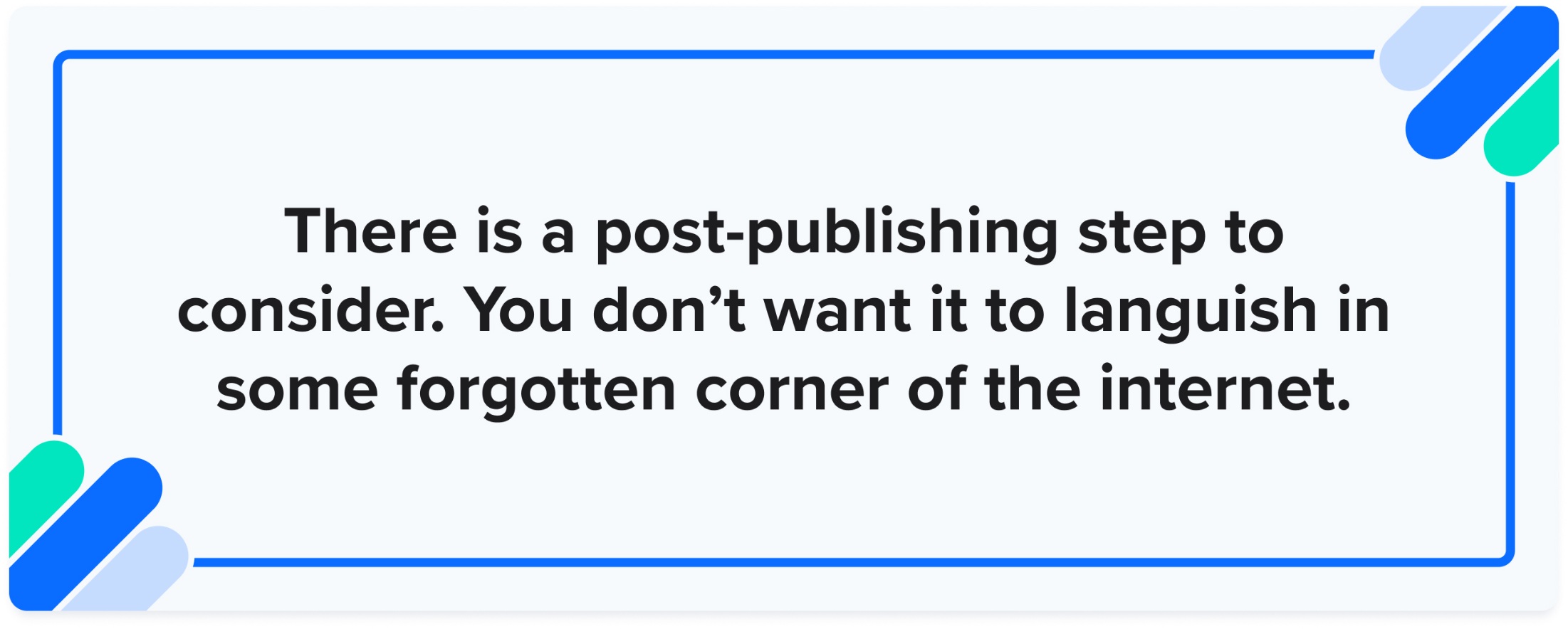
The always-brilliant Andy Crestodina from Orbit Media covers 76 content promotion strategies in this post. Use it to help you think creatively about ways your content can deliver even better results.
Use (and modify) these steps to keep your content creation process on track
Most new content managers suffer from two conflicting, gut-wrenching anxieties:
- Oh my goodness, I’m going to run out of content ideas within the next few days!
- Oh my goodness, there’s no way I’m ever going to be able to write all the content we need!
Strangely, these tend to alternate instead of balancing each other out.
Sometimes you feel like you’re scraping the bottom of the barrel and you’re going to write yourself out of a job. (No content needs means no content manager.)
At other times, you’re facing a sky-high mountain of content needs and you can only type so fast.
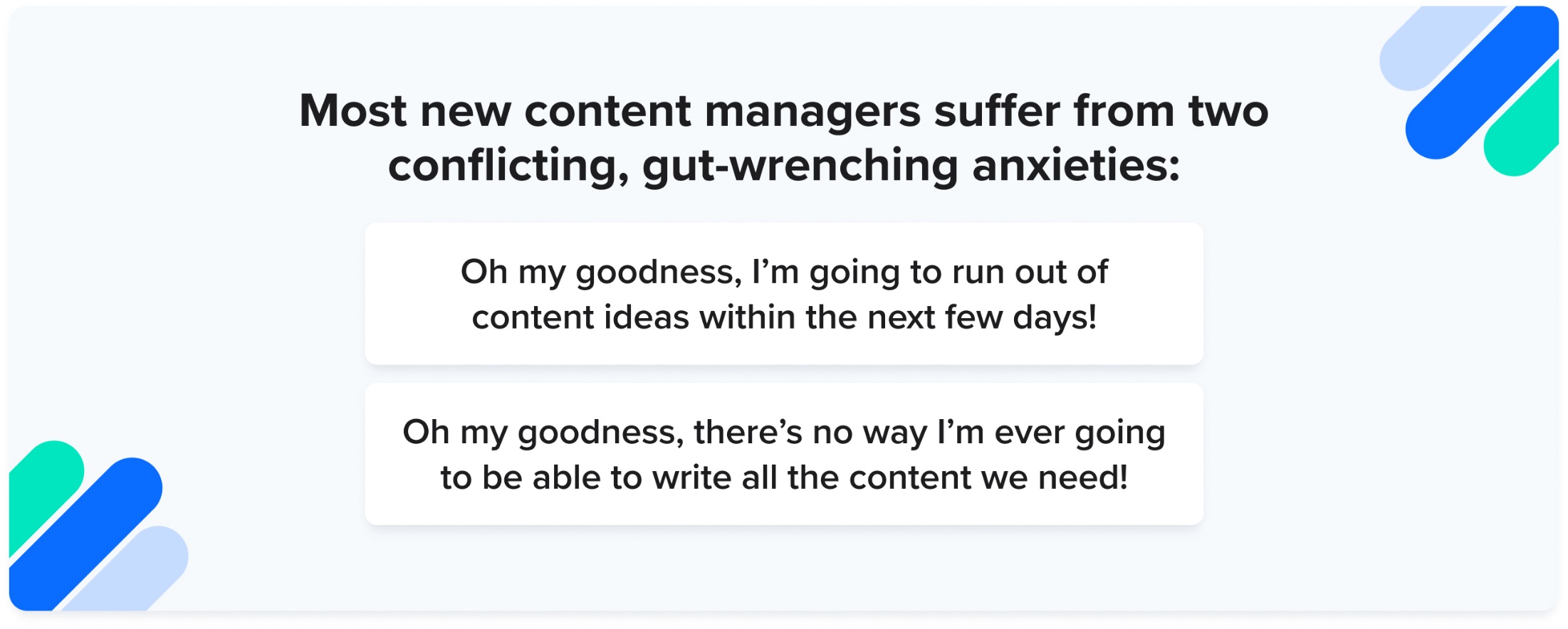
Luckily, the solution to both of these worries is the same: You need to build a stable, consistent process to take each content idea from brainstorm to publication.
If you’ve always got a backlog and an easy way to track progress, you’ll squash these fears and always be on top of your game.
With a process in place that keeps your content moving forward, you’ll be able to move multiple projects ahead simultaneously.
With all this having been said, the writing process is inherently unique to each writer, so you’ll have to tweak this to suit your needs. Your company might have its own specific protocols that change the process, too.
But once you build a process that suits you, you’ve set the foundation for continued success.


Order Your Copy of Marcus Sheridan's New Book — Endless Customers!